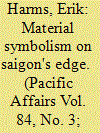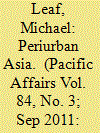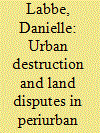| Srl | Item |
| 1 |
ID:
106748


|
|
|
|
|
| Publication |
2011.
|
| Summary/Abstract |
The new urbanization in Vietnam and China, a result of the opening of their economies to the world, the consequent relaxation of central planning, and the sweeping reforms that have had a transforming effect on these countries, has focused attention on the encounters of an ever-expanding urban with the densely populated rural zones-the periurban-that surround large cities in the region. The effects of horizontal expansion on property rights, land use, occupations, social interaction and the physical environment have been ongoing for between 20 and 30 years and have been profound. Some of them are the object of the four case studies that provide the empirical substance of this special issue.
The research reported here was not part of a larger project. It brings together four studies that happened to address interesting aspects of the encounter between urban and rural in two neighbouring countries with socialist regimes that are on the same development trajectory. We do not claim to make vast generalizations, but note the specificities of each case as worthwhile in their own right.
|
|
|
|
|
|
|
|
|
|
|
|
|
|
|
|
| 2 |
ID:
106750


|
|
|
|
|
| Publication |
2011.
|
| Summary/Abstract |
Cities and their fringes are both symbolic and material, imbued with subjective meanings as well as objective physical attributes. In this paper, I show how the physical and social transformation of periurban space in Hô Chí Minh City emerges from and also contributes to a dynamic interaction between symbolic understandings of space as well as material, political economic forces that transform space in concrete ways. On the symbolic level, I show how conceptions of "inside" versus "outside" as well as rural versus urban play into Vietnamese meaning systems that lend a sense of conceptual order and coherence to the larger organization of urban space. In rapidly urbanizing contexts like Hô Chí Minh City, the periurban fringe is dynamic and ever-changing, and the political-economic forces of real-estate speculation, city planning and infrastructure development interact with Vietnamese notions of what an ideal city might look like. This paper shows how periurban spaces in different parts of Hô Chí Minh City can best be understood as spaces of "material symbolism," places where the material attributes of space, the political economy of development, and the symbolic meaning attributed to space all restructure each other in dialectical fashion. Just as symbolic meanings frame how residents perceive these emergent spaces, these same spaces also transform the symbolic meaning of Vietnamese cities.
|
|
|
|
|
|
|
|
|
|
|
|
|
|
|
|
| 3 |
ID:
106753


|
|
|
|
|
| Publication |
2011.
|
| Summary/Abstract |
This commentary on the papers collected in this special issue identifies certain recurring themes from the papers and examines these in light of the urban transitions now being experienced by Vietnam and China, as elsewhere in Asia. These include: tensions in state-society relations as expressed in processes of periurbanization; the effects of the expansion of market relations in land and urban development; the persistence of the discursive categories traditional and modern in the analysis of periurbanization; and a consideration of what the periurban might imply vis-à-vis conventional notions of urban and rural, now and into the future. This discussion of recurring themes from the papers is prefaced by some reflections on how our choices of terminology may influence our theoretical understanding of a situation, event or condition. The specific question here is what is the difference between periurbanization and suburbanization, and it is argued that the distinction between the two may derive more from who is using the terms and the contexts within which they are situated than from specific denotative meanings of the words.
|
|
|
|
|
|
|
|
|
|
|
|
|
|
|
|
| 4 |
ID:
106749


|
|
|
|
|
| Publication |
2011.
|
| Summary/Abstract |
This paper discusses the recent rise in land disputes in the rapidly urbanizing outskirts of Hanoi. It presents emerging social conflicts as resulting from a clash between the rules and practices of urbanization as devised and regulated locally by periurban people and the territorialization projects that municipal authorities and land developers try to impose on them. At the heart of these conflicts are expropriations of large tracts of periurban land by state-backed developers and the reforms of local institutions that facilitate this process. Using the case of a village recently annexed to the city, this paper examines how local people resort to contentious politics to resist this urban encroachment. The paper finds that groups of elderly villagers assumed a leading role in crafting and deploying acts and discourses of resistance, relying on state-promoted values to support their claim. It further suggests that, while periurban villagers acknowledge the necessity of integrating their locality into Hanoi's urban fabric and governance system, they rise up when this process threatens moral relationships inherited from the prerevolutionary and collectivization periods.
|
|
|
|
|
|
|
|
|
|
|
|
|
|
|
|